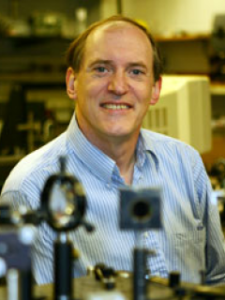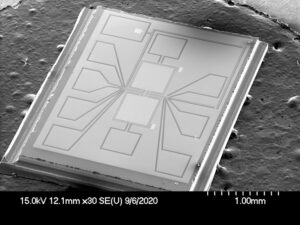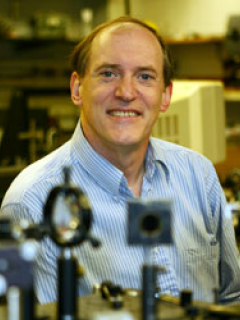
EeroQ, a leader in quantum computing that uses electrons on helium, announces the appointment of Princeton University Professor Steve Lyon as Chief Technology Officer. Professor Lyon will also retain duties at Princeton University.
“Today, the most commonly known platforms to build quantum computers are superconducting circuits, trapped ions, silicon spins, and photonics,” said Nick Farina, EeroQ CEO. “However, since 2016 EeroQ has been focused on exploring a fifth pathway that may offer a best-of-all-worlds approach: electrons on helium. Professor Lyon will allow us to explore the potential of this technology fully.”
Professor Lyon brings decades of experience in semiconductor physics and engineering to EeroQ’s effort to bring electrons on helium to the forefront of global QC race, according to the company.
EeroQ Co-Founder Faye Wattleton added, “EeroQ has built a multidisciplinary team to tackle the societal as well as technical challenges of building a large scale quantum computer. The addition of Professor Lyon to our team will continue our rapid engineering progress.”

TQD Exclusive
We talked to Nick and Dr. Lyon about what the announcement means for EeroQ, quantum science and the quantum industry.
What does Prof. Lyon’s appointment mean for EeroQ?
Nick Farina: Well, this one is simple. It allows EeroQ to bring electrons on helium (eHe) more rapidly to the forefront of quantum computing approaches. eHe has a great deal of potential, promising the long coherence and high connectivity of ion traps combined with the fast gates of superconducting circuits or silicon spin qubits. Plus, electrons are small, so you can get millions of them on a single chip manufactured using standard CMOS. The problem is, eHe is at an earlier stage of development than some other qubit platforms. If you want to make an eHe commercial quantum computer before the end of the decade then you need all hands on deck right now, and Prof. Lyon is one of the best minds in this field. On a more technical level, when EeroQ was formed in 2016 our focus was on using motional states of electrons bound to helium as the qubits for our quantum computer. However, Prof. Lyon convinced us that the ultimate focus should be on the electrons’ spin.
 Why is your technology different? What are the advantages with your approach?NF: eHe is a novel technology and very different from other qubit platforms, and it’s quite fun to describe. In our approach to building a quantum computer, the qubit is an electron trapped in vacuum above the surface of superfluid helium, using microwaves for quantum logic gates. This is one of the cleanest systems known to exist, so while it’s challenging to work with it offers a somewhat natural “home” for quantum computation.
Why is your technology different? What are the advantages with your approach?NF: eHe is a novel technology and very different from other qubit platforms, and it’s quite fun to describe. In our approach to building a quantum computer, the qubit is an electron trapped in vacuum above the surface of superfluid helium, using microwaves for quantum logic gates. This is one of the cleanest systems known to exist, so while it’s challenging to work with it offers a somewhat natural “home” for quantum computation.
Steve Lyon: The original idea for using electron spins on helium as qubits was to make a condensed-matter qubit with very long coherence, even for mobile qubits. That is still important, but in testing devices we found that they are very uniform and reproducible. That is not particularly important for satisfying the original DiVincenzo criteria, but can be hugely important for scaling. Electrons bound to helium are expected to have some properties that are similar to trapped ions or cold atoms – mobile, identical qubits with long coherence; but at the same time they are predicted to share properties with electron spin qubits in silicon – small (sub-micron devices), fast exchange-based 2-qubit gates, and direct integration with silicon technology. They promise the size, speed, and manufacturability of solid-state devices with the coherence, and uniformity of ions or atoms. While other technologies have concentrated first on demonstrating all of the DiVincenzo criteria, our approach has been to identify a system that has a clear path to doing quantum operations, but then to concentrate on evaluating its suitability for scaling. In the end, a successful technology must do both – a full set of quantum operations as well as scale to millions or billions of physical qubits, and scaling to that level is very difficult. We believe electrons on helium can scale to many qubits on a single chip, particularly as the technology is compatible with standard CMOS.
What about Prof. Lyon’s background-experience-etc. make him a good fit for EeroQ?
NF: Well, the field of electrons on helium is quite small. There are fewer than ten people globally who are experts in this technology, and Prof. Lyon is among the most experienced and well respected of those folks. He’s been working on various semiconductor quantum devices since the 1980s, and began working on spin-based qubits in silicon about 20 years ago. His research showed that while tightly bound electrons in silicon could have long spin coherence – over 10 seconds – mobile electrons in silicon decohere in a few microseconds. This led him to propose using electrons bound to superfluid helium as spin qubits, and he has had a research program in that area since 2006. Prof. Lyon is a world leader in spin qubits, so we decided to join forces to accelerate and enhance our engineering progress.
Could Prof. Lyon give us an idea of why he is interested in/excited about the opportunity to advance eHe?
SL: Half a dozen different physical systems have now demonstrated the necessary quantum operations (DiVincenzo Criteria) for quantum computing, but as we have learned more about quantum error correction it has become clear that scaling to the large sizes required for full-scale universal quantum processors will be a major challenge. Electrons bound to helium has been a relatively small research field, and while significant progress has been made there has not been time to pursue many fruitful avenues. Working with EeroQ will allow us to pursue some of these avenues and advance the field much more rapidly.
“We are strictly focused on hardware, and bringing a commercial quantum computing chip to market by the end of this decade.”
What are the ultimate — big picture — goals of EeroQ, in the technological, scientific and societal sense?
NF: On the business and technology side, our goal is clear. We are strictly focused on hardware, and bringing a commercial quantum computing chip to market by the end of this decade. We have chosen not to focus on any projects involving applications or software in order for us to move as rapidly as possible on developing our chip. We are a chip design company, so we are just focused on what we are good at.
On the societal end, we are all still trying to figure that out. We’ve been focused on the question of ethics in quantum computing since 2018, and recently that topic has gotten some criticism for being vaguely defined and too insider. That’s fair. We’re working with external stakeholders to try and figure out how we can more effectively define ethical standards for quantum computing. At a baseline, we believe the makers of a technology must think about its potential use and educate stakeholders across the spectrum about their technology (in this case QC) and how it might be used. It’s still very early days for the industry, but that is good news because it means we have a good bit of time to think about this problem before we see commercial application of the technology. We don’t expect to see useful commercial applications in quantum computing for a few more years.
“One difference from other technologies is that we do not plan to make just single quantum devices at each stage, but instead to continue fabricating arrays of devices on each chip, to better understand the scaling challenges and factor that information into the device design.”
What are some of the next key milestones?
SL: The first goal is to couple the lateral motion of an electron to a microwave resonator. Putting two electrons into such a structure looks like the most direct path to the measurement of the spin of individual electrons. With single-spin measurement we will begin testing designs we have for 1- and 2-qubit gates, test how electron transport affects the spin coherence, and build up all of the capabilities we will need for a fully error-corrected universal quantum computer. One difference from other technologies is that we do not plan to make just single quantum devices at each stage, but instead to continue fabricating arrays of devices on each chip, to better understand the scaling challenges and factor that information into the device design.
NF: I’ll add that EeroQ has been gestated in essentially two stages. We began working on this in 2016, with the goal of bridging the gap between basic research on this system and commercial engineering. We did a mix of sponsored research and internal chip design to get to where we are today. Now, between our progress and the addition of Prof. Lyon to the team, we are really hitting the gas on our effort, spinning out of the lab and into our own engineering facility which we plan to build out in Chicago.
What is the long-term goal?
SL: As we get towards the end of this decade, we expect that several technologies will have quantum processors with a few hundred or few thousand physical qubits, and which are capable of supporting a few fully error-corrected logical qubits. Our goal is to be in a similar position in that time frame. Systems with those sorts of qubit counts are predicted to be able to be useful for some niche commercial applications. However, that will also be the time frame for the beginning of the extremely difficult job of scaling up our quantum systems by another 3 – 5 orders of magnitude to make a full-scale universal quantum computer. By baking scaling into our devices from the beginning, we believe that we will have a leg up on that process.
Princeton recently offered a video tour of Dr. Lyon’s clean room facilities.
If you found this article to be informative, you can explore more current quantum news here, exclusives, interviews, and podcasts.

















